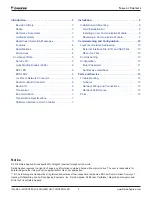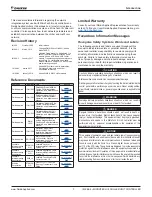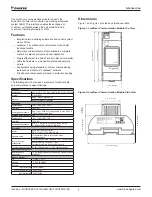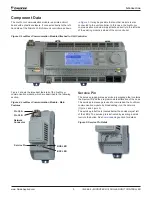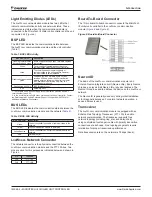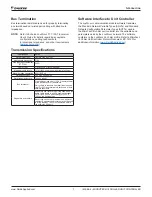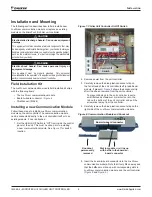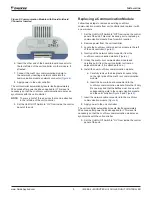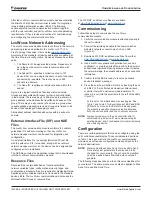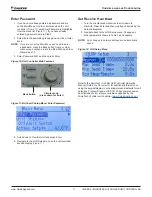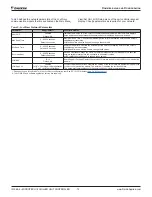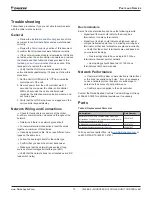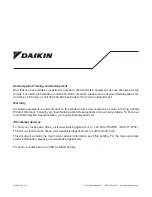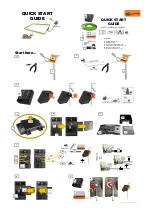
IM 968-4 • MICROTECH III CHILLER UNIT CONTROLLER 10 www.DaikinApplied.com
C
ommIssIonIng
and
C
onfIguraTIon
C
ommIssIonIng
and
C
onfIguraTIon
After the
L
on
W
orks
communication module has been installed,
the MicroTech III chiller unit controller is ready for integration
into a building automation system (BAS). The following
section explains how the communication module, together
with the unit controller, support
L
on
W
orks
network addressing
requirements. It then provides instructions for commissioning
and configuring the communication module.
L
on
W
orks
Network Addressing
The
L
on
W
orks
communication module conforms to the network
addressing rules as described in the
L
on
W
orks
FTT-10A
Free Topology Transceiver Users Guide (
www.echelon.com)
.
According to the standard, all device addresses are defined at
the time of network configuration. Device addresses have three
parts:
1. The Domain ID - designates the domain. Devices must
be in the same domain in order to communicate with
each other.
2.
The Subnet ID - specifies a collection of up to 127
devices that are on a single channel or a set of channels
connected by repeaters. There may be up to 255
subnets in a domain.
3.
The Node ID - identifies an individual device within the
subnet.
A group is a logical collection of devices within a domain.
Groups are assembled with regard for their physical location
in the domain. There may be up to 256 groups in a domain. A
group address is the address that identifies all devices of the
group. There may be any number of devices in a group when
unacknowledged messaging is used. Groups are limited to 64
devices if acknowledged messaging is used.
A broadcast address identifies all devices within a subnet or
domain.
External Interface File (XIF) and NXE
Files
The
L
on
W
orks
communication module conforms to LonMark
guidelines. It is self-documenting so that any
L
on
W
orks
network management tool can be used for integration and
configuration.
An external interface file (a specially formatted PC text file
with the extension .XIF) is required, along with a
L
on
W
orks
network management tool, so the device can be designed and
configured prior to installation.
The NXE file contains the application image that is downloaded
into the
L
on
W
orks
communication module.
Resource Files
Resource files contain definitions of functional profiles,
network variables types, configuration property types, and
enumerations. Resource files are required for displaying Daikin
Applied-specific variables that are not included in the standard
device profile. The
L
on
W
orks
communication module uses the
McQuayChiller (Scope 5) resource files.
The XIF, NXE, and Resource files are available
at
www.DaikinApplied.com
or
www.lonmark.org
.
Commissioning
Follow these steps to commission the
L
on
W
orks
communication module:
1. Verify the communication module is attached properly to
the unit controller.
2. Connect the twisted pair cable to the communication
module’s network connector pins CLA and CLB
(
Figure 4
).
3. Download XIF, NXE, and Resource Files from either
www.DaikinApplied.com
or
www.lonmark.org
.
4. Use a
L
on
W
orks
network configuration tool, such as
LonMaker
®
, to map the device Neuron ID to the domain/
subnet/node logical addressing scheme when it creates
the network image, the network address, and connection
information.
5.
Confirm that the BAS is ready to receive a network
device broadcast message.
6. Press the service pin button. Do this by inserting the end
of a 5/64” (2.0 mm) flathead screwdriver, Allen wrench,
or similar tool with a narrow end, approximately 1.5
inches (3.8 cm) into the small hole to the left of the LEDs
(
Figure 5
).
At this point, the initialization process begins. See
Table 1
and
Table 2
for descriptions of BSP and BUS
LED activity. Once both LEDs turn a steady green,
the module is capable of communicating between
both the unit controller and the
L
on
W
orks
network.
NOTE:
Always cycle power to the unit controller after 1)
commissioning a device, 2) de-commissioning an
existing device, and 3) subsequent re-commissioning
of an existing device.
Configuration
There are certain parameters that can be configured using the
unit controller keypad/display. These variables are described
in
Table 3
. As a general rule, the
L
on
W
orks
communication
module does not require configuration unless advised by the
network administrator.
NOTE:
Receive Heartbeat, Max Send Time, and Min Send
Time are typical parameters that may need to be
changed for your network. They should be modified
on an as-needed basis. Maintain default values if
possible.
The following steps describe how to set Receive Heartbeat for
your network. The same procedure can also be applied to Max
Send Time and Min Send Time.


